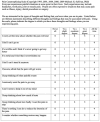The role of pain catastrophising on subjective function and pain following total hip arthroplasty: a prospective comparative study of 531 patients with 2-year follow-up
- PMID: 40079365
- PMCID: PMC12069825
- DOI: 10.1177/11207000251325230
The role of pain catastrophising on subjective function and pain following total hip arthroplasty: a prospective comparative study of 531 patients with 2-year follow-up
Abstract
Background and purpose: Considering dissatisfaction rates of around 10% after total hip arthroplasty (THA), this study aimed to investigate the role of pain catastrophising (PC) on functional outcomes, pain, and quality of life following THA in a large prospective study. PC is the tendency to focus on and exaggerate painful stimuli combined with a decreased ability to deal with pain.
Patients and methods: A prospective comparative study was performed with 531 patients undergoing primary unilateral THA between 2019 and 2020. Patients were considered PC with a preoperative score ⩾30 on the PC Scale, resulting in 57 (11%) PC-patients. Patient-reported outcome measures (PROMs) were collected preoperatively, at 3 months, 1 year, and 2 years postoperatively and consisted of Hip disability and Osteoarthritis Outcome Score-Physical Function (HOOS-PS), Oxford Hip Score (OHS), pain (NRS), and quality of life (EQ-5D), including minimal clinical important differences (MCIDs) and patient acceptable symptom state (PASS), as well as length of stay and aseptic revisions.
Results: PC-patients reported inferior preoperative scores on all PROMs and had longer hospital stay (p = 0.02). Although PC-patients had more improvement in all scores and a higher proportion generally reached MCID, they still reported lower OHS, more pain, and lower EQ-5D at 2-year follow-up (all p < 0.03), and fewer PC-patients reached PASS for OHS and EQ-5D at final follow-up. No difference in aseptic revisions was seen (p = 0.95).
Conclusions: PC-patients had worse preoperative subjective function and more pain. Although they showed more improvement than non-PC patients at all outcomes, less patients reached PASS for OHS and EQ-5D at 2-year follow-up.
Keywords: Arthroplasty; hip osteoarthritis; hip replacement; pain catastrophising; psychological factors; total hip arthroplasty.
Conflict of interest statement
Declaration of conflicting interestsThe author(s) declared no potential conflicts of interest with respect to the research, authorship, and/or publication of this article.
Figures



References
-
- Sloan M, Premkumar A, Sheth NP. Projected volume of primary total joint arthroplasty in the U.S., 2014 to 2030. J Bone Joint Surg Am 2018; 100: 1455–1460. - PubMed
-
- LROI. Number of registered hip arthroplasties per year of surgery (2007-2021) in the LROI in May 2022, https://www.Lroi-Report.nl/Hip/Numbers/2022 (2022, accessed 08 December 2022).
-
- Toci GR, Magnuson JA, DeSimone CA, et al. A systematic review and meta-analysis of non-database comparative studies on cemented versus uncemented femoral stems in primary elective total hip arthroplasty. J Arthroplasty 2022; 37: 1888–1894. - PubMed
-
- Gademan MGJ, van Steenbergen LN, Cannegieter SC, et al. Population-based 10-year cumulative revision risks after hip and knee arthroplasty for osteoarthritis to inform patients in clinical practice: a competing risk analysis from the Dutch Arthroplasty Register. Acta Orthop 2021; 92: 280–284. - PMC - PubMed
Publication types
MeSH terms
LinkOut - more resources
Full Text Sources
Medical

